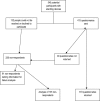The impact of supported standing on well-being and quality of life
- PMID: 24396162
- PMCID: PMC3817885
- DOI: 10.3138/ptc.2012-27
The impact of supported standing on well-being and quality of life
Abstract
Purpose: To identify the characteristics of people who use standing devices and to explore their degree of device use, experiences with and reasons for standing, and perceived impact of the use of standing devices on well-being and quality of life (QOL).
Method: Anyone with a current prescription at the time for the study in any of five counties in Sweden (n=545), according to a national register of prescribed devices, was invited to participate in a descriptive survey; the questionnaire was mailed to respondents for self-rating.
Results: People between 2 and 86 years old were represented among respondents. Standing time decreased with increased age. Respondents who were totally dependent for mobilization or who had received their standing device more than 5 years earlier used their device most frequently. The most common reasons given for standing were to improve circulation and well-being and to reduce stiffness.
Conclusion: It is important to pay attention to the experiences of standing for this vulnerable group of people, as the use of a standing device has a positive impact on well-being and QOL.
Objectif : L'étude visait à déterminer les caractéristiques des personnes qui utilisent des appareils de verticalisation, à explorer leurs expériences de la position debout, le degré d'utilisation des appareils, la raison pour laquelle elles se tiennent debout et l'effet perçu sur le bien-être et la qualité de vie. Méthode : Sujets : Toutes les personnes à qui l'on a prescrit des appareils de verticalisation (n=545) dans cinq comtés de la Suède ont été invitées à participer à l'étude. Concept : Sondage descriptif. Procédure : Les répondants ont été recrutés à partir d'un registre national des appareils prescrits. Un questionnaire d'auto-évaluation a été envoyé aux répondants par la poste. Résultats : Les répondants au questionnaire sur l'utilisation d'appareils de verticalisation représentaient tous les âges. Le temps passé en position debout diminuait selon l'âge. Les répondants qui étaient totalement dépendants pour l'ambulation ou qui avaient reçu l'appareil il y a plus de cinq ans utilisaient leur appareil le plus souvent. Les sujets se tenaient debout le plus souvent pour améliorer leur circulation, pour contrer les raideurs et pour leur bien-être. Conclusion : Il importe d'accorder de l'attention aux expériences de la position debout pour la santé dans ce groupe vulnérable de personnes, car l'utilization d'appareils de verticalisation a un effet positif sur le bien-être et la qualité de vie.
Keywords: disabled persons; postural balance; quality of life; self-help devices.
Figures
Similar articles
-
The psychosocial impact on standing devices.Disabil Rehabil Assist Technol. 2014 Jul;9(4):299-306. doi: 10.3109/17483107.2013.807443. Epub 2013 Jun 19. Disabil Rehabil Assist Technol. 2014. PMID: 23782225 Free PMC article.
-
Erratum.Mult Scler. 2016 Oct;22(12):NP9-NP11. doi: 10.1177/1352458515585718. Epub 2015 Jun 3. Mult Scler. 2016. PMID: 26041800
-
Factors affecting prescription and implementation of standing-frame programs by school-based physical therapists for children with impaired mobility.Pediatr Phys Ther. 2009 Fall;21(3):282-8. doi: 10.1097/PEP.0b013e3181b175cd. Pediatr Phys Ther. 2009. PMID: 19680071
-
The dual task-cost of standing balance affects quality of life in mildly disabled MS people.Neurol Sci. 2016 May;37(5):673-9. doi: 10.1007/s10072-015-2456-y. Epub 2016 Jan 4. Neurol Sci. 2016. PMID: 26728268
-
A Descriptive Study to Explore the Effect of Peristomal Skin Complications on Quality of Life of Adults With a Permanent Ostomy.Ostomy Wound Manage. 2017 May;63(5):10-23. Ostomy Wound Manage. 2017. PMID: 28570245
Cited by
-
Passive standing as an adjunct rehabilitation intervention after stroke: a randomized controlled trial.Arch Physiother. 2015 Jul 8;5:2. doi: 10.1186/s40945-015-0002-0. eCollection 2015. Arch Physiother. 2015. PMID: 29340171 Free PMC article.
-
Application of a paraplegic gait orthosis in thoracolumbar spinal cord injury.Neural Regen Res. 2016 Dec;11(12):1997-2003. doi: 10.4103/1673-5374.197144. Neural Regen Res. 2016. PMID: 28197198 Free PMC article.
-
Sliding and lower limb mechanics during sit-stand-sit transitions with a standing wheelchair.Biomed Res Int. 2014;2014:236486. doi: 10.1155/2014/236486. Epub 2014 Jul 6. Biomed Res Int. 2014. PMID: 25105120 Free PMC article. Clinical Trial.
-
"I'm in a very good frame of mind": a qualitative exploration of the experience of standing frame use in people with progressive multiple sclerosis.BMJ Open. 2020 Oct 28;10(10):e037680. doi: 10.1136/bmjopen-2020-037680. BMJ Open. 2020. PMID: 33115893 Free PMC article. Clinical Trial.
-
Sensor Fusion to Infer Locations of Standing and Reaching Within the Home in Incomplete Spinal Cord Injury.Am J Phys Med Rehabil. 2017 Oct;96(10 Suppl 1):S128-S134. doi: 10.1097/PHM.0000000000000750. Am J Phys Med Rehabil. 2017. PMID: 28379922 Free PMC article.
References
-
- Glickman LB, Geigle PR, Paleg GS. A systematic review of supported standing programs. J Pediatr Rehabil Med. 2010;3(3):197–213. Medline:21791851. - PubMed
-
- Arva J, Paleg G, Lange M, et al. RESNA position on the application of wheelchair standing devices. Assist Technol. 2009;21(3):161–8. quiz 169–71. http://dx.doi.org/10.1080/10400430903175622. Medline:19908680. - DOI - PubMed
-
- Ellis-Hill C. Identity and sense of self: the significance of personhood in rehabilitation. JARNA. 2011;14(1):6–12.
-
- Nordström B, Näslund A, Ekenberg L. On an equal footing: adults' accounts of the experience of using assistive devices for standing. Disabil Rehabil Assist Technol. 2013;8(1):49–57. http://dx.doi.org/10.3109/17483107.2012.678031. Medline:22519553. - DOI - PubMed
-
- Dunn RB, Walter JS, Lucero Y, et al. Follow-up assessment of standing mobility device users. Assist Technol. 1998;10(2):84–93. http://dx.doi.org/10.1080/10400435.1998.10131966. Medline:10339284. - DOI - PubMed
LinkOut - more resources
Full Text Sources
Other Literature Sources



